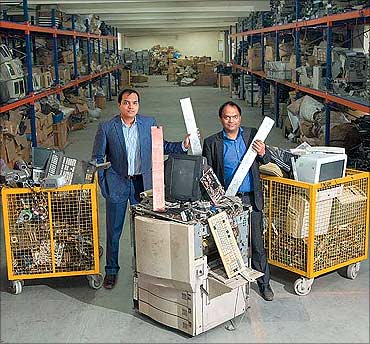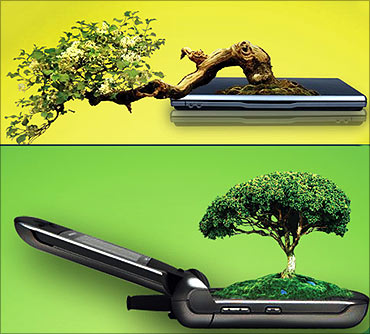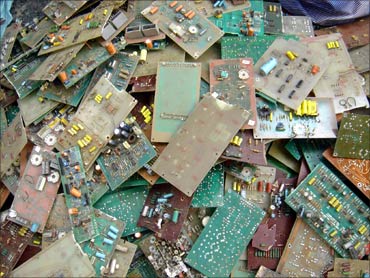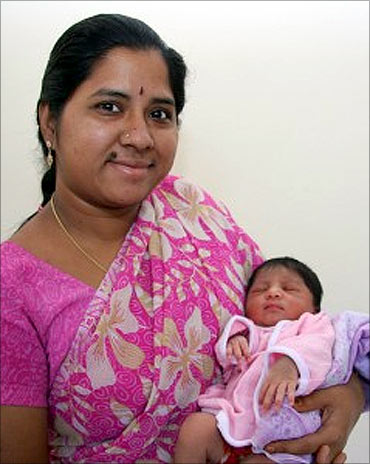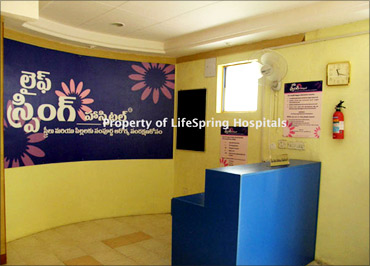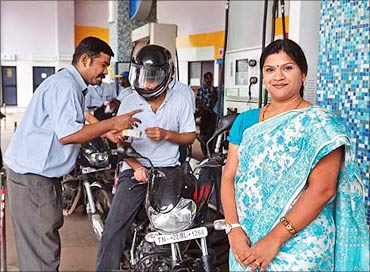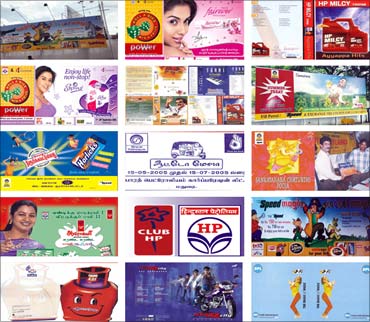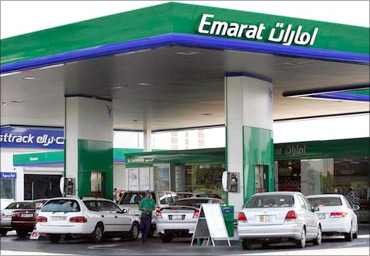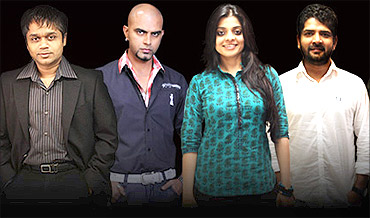This article was first published 14 years ago
Home »
Business » How 5 employees became successful employers
How 5 employees became successful employers
Last updated on: February 2, 2011 11:35 IST
Image: Be your own boss.
You cannot choose your boss, they say. While true in most situations, it doesn't mean you cannot boot the boss out of your life.
Many a smart, hard-working subordinate knows that the only way to maximise their financial valuation is by working for themselves, not anyone else. Only a handful of them, however, have been able to transform thought into action.
There are two main reasons for this. The first is risk. Economists distinguish between salaries and profits.
The first is the remuneration for labour. The second is for risk borne by an entrepreneur. However fat a salary someone may draw, the profits, the real big money, will always go to the person he works for - his boss and the bearer of the risk.
Image: No happy-go-lucky entrepreneur.
The second and, perhaps, more important thing is passion. Nobody has heard of a successful, happy-go-lucky entrepreneur.
Inventor Thomas Alva Edison had famously described genius as 1 per cent inspiration and 99 per cent perspiration. It holds for entrepreneurs too. These are driven men, willing to work 24x7x365 - for that 1 per cent, the idea, their baby.
In this, the first story of our new section, Enterprise, we spoke with five entrepreneurs who had dumped the 'boss'. Their businesses are as diverse, both in scope and sector, as their location and backgrounds.
What is common, apart from their risk-taking ability and passion, is that their businesses have broken even. Here are the stories of how they did it. (We hope it will be your 1 per cent solution too.)
Image: Nitin Gupta (R), Rohan Gupta.
Attero: Cash in e-Trash Little did Nitin Gupta, 32, and Rohan Gupta, 30, know that a trip to New Delhi's Nehru Place computer market in early 2007 would change the course of their lives.
From Dehradun, Nitin was then working for Lotus Interworks in the US after doing his MBA from the Stern School of Business at New York University.
Brother Rohan, a chemical engineer by training, was working in Bangalore. Nitin had brought Rohan a laptop, so the two went out to sell the old one. While they waited, they asked the shopowner what he did with old machines.
City of location: New Delhi
Date of launch: February 2008
Initial startup capital: $6.3 million (about Rs 26 crore)
External funding if any: Draper Fisher Jurvetson, NEA-Indo US Ventures
Date of break-even: Quarter ended September 2010
Performance indicator: Processes 3,600 tonnes of e-waste per annum
Turnover: $1 million (about Rs 4.5 crore) in 2009-10
Image: Attero makes e-waste eco-friendly.
If it was workable, he said, it would be fixed and sold off cheap. If not, it would go to a scrap dealer. On the way back, the brothers decided to scope what happened to the computers -and mobile phones and printers and so on -that had lived out their working life.
"Most of it ended up in landfills," says Nitin, "with all the hazardous material. Some of the rest was melted in acid to extract metals but that acid, too, was literally poured down the drain." Not eco-friendly at all.
Image: Solving the e-waste problem.
There were recyclers too. They took the e-waste, separated the scrap according to the material it was made of, and sold them to companies that could make something out of it.
Many parts with non-ferrous metals-copper, lead, aluminium, gold, silver, platinum, palladium-would be exported as nobody in India had the technology to extract the various metals.
That, they figured, is where the money was. "It's like BPO - the higher you go up the chain, the greater the money," says Rohan.
Image: 130 million mobiles sold every year.
Suddenly, there was an idea. "With about 130 million mobiles sold every year, at least half of them as replacements, there was a big source of material," says Nitin. Add the computers and peripherals and things get even bigger.
In February 2008, Attero Recycling was incorporated. In April the same year, it got $6.3 million (about Rs 26 crore) of funds from private equity companies Draper Fisher Jurvetson and Vinod Dham's NEA Indo-US Ventures.
To take the benefit of the 10-year tax holiday, the 36,000 tonnes per annum plant was set up in the industrial zone in Roorkee, Uttarakhand. "This plant needs no human intervention," says Nitin about the shredder and separator.
Image: Processing tonnes of e-waste.
That apart, there are smelters that makes billets and an electrolysis unit that uses a patent pending technology to extract non-ferrous metals, both precious and non-precious, of 99.99 per cent purity.
These are sold on the MCX and provide the company about 90 per cent of its revenue currently. The rest comes from companies (there are 185 on the client list now), some of which pay a fee to Attero to dispose of their e-waste. The problem, though, is elsewhere.
"Even large corporates do not care about the way their e-waste is disposed of," says Nitin, adding, "it takes a lot of convincing to make them give their scrapped computers and peripherals to us."
He is hoping that changes in law and increased awareness will help the business grow. As of now, the plant is processing 3,600 tonnes of e-waste a year.
Image: Nitin Gupta.
The other complicated bit is the reverse logistics network, which moves e-waste from all over the country to Roorkee. This sourcing and transportation network, along with the metal extraction technology, is likely to keep Attero's rivals at bay.
But true to their entrepreneurial spirit, Nitin and Rohan are on the lookout for more revenue streams. Non-cyclable plastics is one. The research team is trying out a pyrolysis process to extract carbon black and furnace oil from it -there's good demand for both.
They are also researching related gadgets. That apart, usable parts of computers are being separated and assembled into PCs that are sold for about Rs 4,000 a piece to those who cannot afford new ones, with a takeback and recycle guarantee.
In 2010, two more rounds of funding, from Granite Hill Capital Partners and International Finance Corporation brought it another $8.3 million (about Rs 37 crore). Every time the Guptas find the gold, the rest of the world can hope for a rainbow above it.

Image: Anant Kumar.
Life Spring: Happy Moms, Healthy Babies The glass door to his rather airy, un-air-conditioned and sparsely furnished office on the top floor of a brightly painted, but humble-looking building in downtown Secunderabad does not have an engraved nameplate.
Instead, you find stuck on it an A4 sized printout with the letters 'An' followed by the picture of an ant. Makes you wonder if it relates to the industrious little creature. Then, the answer to the on-your-face rebus dawns on you.
'An-ant' Kumar, founding CEO of Life Spring Hospitals - an expanding chain of hospitals providing high-quality, low-cost maternity care to low-income women - is not your typical honcho.
He walks to his nearby home occasionally for lunch, often climbs up the stairs to his fifth-floor office, stopping by to wave to the nurses, or speak to happy new moms.
City of location: Hyderabad
Date of launch: 1st hospital launched in December 2005
Initial startup capital: Rs 7.5 crore
External funding if any: Startup capital provided by Hindustan Latex. Raised the next Rs 7.5 crore from Acumen Fund in 2007
Date of break-even: 1st hospital broke even in an year
Performance indicator: 9 hospitals
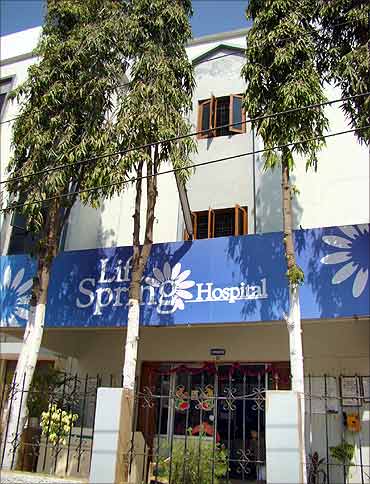
Image: Life Spring Hospital.
The 'birth' of the idea can be traced back to his days at Institute of Rural Management and his subsequent stint at Hindustan Latex (now, Hindustan Lifecare).
Kumar's job was to promote the use of contraceptives in rural belts of Uttar Pradesh and Andhra Pradesh, where he was struck by long queues of pregnant women at government hospitals. "Why can't these women get quality treatment at a low cost?" he wondered.
Kumar found a mentor in Hindustan Latex chairman M. Ayyappan, who allowed him to take it up as a project within the company. It meant he could pursue his dream without chucking the job.
Image: A big social impact.
For two years he was without an office, doing research, testing hypotheses, talking to people and approaching seed investors. The reactions ranged from incredulity to mock sympathy.
"If this is a viable model, why hasn't anyone (read: Apollo Hospitals) tried it before?" guys at a leading bank told him. "You will just be competing with and not complementing us," was the government's response.
Some thought he wanted to start an NGO. But Kumar was dead against a grant-based model. He was looking only for viability gap funding.
Meanwhile, Kumar got himself a one-year hospital management diploma and did a couple of months' stint at a hospital.
In March 2005, Hindustan Latex provided an initial round of funds and, suddenly, Kumar was faced with the challenge of recruiting a team, setting up a hospital and getting it rolling. All in a year's time. Naturally, there were hiccups.
Image: Life Spring makes mothers happy.
The owner who had agreed to lease his building reneged at the last moment. Then, the newly built building got flooded, followed by snags in equipment.
"We were doing something new. There wasn't any model we could copy-paste," says Kumar. Precisely why he has, in most parts, hired professionals from all sectors barring the hospital sector, so that none came with any prior baggage.
At Life Spring, you never have a patient; they are all 'customers'. And, hence, you find the best facilities - good doctors, semi-private general wards, 24x7 helpline. There are no secretaries, false-ceilings, marbled floors, or central air-conditioning - anything that does not 'add value'.
Image: Life Spring Hospital.
The hospital at Moula Ali got running in December 2005. In February 2006, the first baby was born. The business broke even within a year.
By early 2007, Kumar had got his second round of funding and, in beginning 2008, a separate company was formed.
Five years on, Kumar still remembers preparing the first bill for the customer. "From stopping babies coming to this world, here I was, ensuring that happy and healthy babies are born," he grins.
Image: Life Spring Hospital.
Talks on a scheme to pay for a birth through instalments, however, didn't materialise. The banker told him: "I understand what you are saying. But this is different from a car or a fridge. We can't take away the baby if there is a default in payment!"
A few rooms away, the conference room, named after Vanaja, the first mother to give birth at the Moula Ali hospital, showcases the different awards Life Spring has received.
As we take a look, a faint but piercing cry of a newborn wafts through from one of the floors below. There could, perhaps, be no better award for Kumar and his team.
Image: Pratyaksh Bhagi (R) and Ajay Yadav.
Diet Foods: A healthy spread After what seemed like a never-ending search in the alleys of Goregaon, there couldn't have been a more welcoming drink than the chilled Jaljeera straight from the kitchen of Diet Delivery, a diet meal service in Mumbai.
Started in 2009 by young entrepreneurs Pratyaksh Bhagi and Ajay Yadav, both in their late 20s, Diet Delivery promises to keep your calorie count under check.
For a city bustling with outsider majority, a place to order quality, low on oil, nutrition rich meal is indeed a blessing.
City of location: Mumbai
Date of launch: May 2009
Initial startup capital: Rs 3 lakh (Rs 1.5 lakh each)
External funding if any later raised: Rs 10 lakh from friends
Date of break-even: September 2010
Performance indicator: Caters 750 meals a day
Turnover/profit: Rs 1.3 crore/Rs 35 lakh in 2010
Image: Diet Delivery's supply chain.
Of course, this was the thought Bhagi and Yadav found promising. It wasn't easy.
"Everyone is confident about their own idea, but there is always struggle," says Bhagi, who left his job as a banker with Kotak Mahindra Bank after a two-and-a-half-year stint, for his passion for business. Yadav, whose family runs a restaurant in Mumbai, had also thought of doing something on a moderate scale, but on his own.
Recession had set in and the restaurant was not doing well. Moreover, with three brothers and a single restaurant, it was better to move out.
Bhagi and Yadav, friends since 1999, started their journey with an investment of Rs 1.5 lakh each. "Most of the money went into R&D," says Yadav.
At first, they gave meals for free sampling. With the help of friends, they prepared a questionnaire and, based on the responses, finalised the pricing and other decisions.
Image: Diet Delivery for healthy food.
Every meal is prepared under the instructions of their consultant chef, Vishal, who works with a high-end restaurant in the town.
A nutritionist, Dr Panchali Moitra, oversees the calorie content. Prices vary from Rs 95 to Rs 149, depending on the cuisine.
They have tied up with dabbawalahs for smooth delivery. Diet Delivery's website is clutter-free and pleasing. Says Bhagi, "With every meal, you know how many calories you are consuming. This is not possible at any restaurant."
The initial targets were call centre employees. "They are a young crowd and would rather spend their money on partying or something flashier," explains Bhagi.
Next, they targeted corporates. They decided to sell the idea of 'good food for employees' to the HR departments of companies. Who knew that convincing them would be tougher than convincing the CEOs?
Image: A healthy food service.
Says Bhagi about the initial efforts: "We were confident that word of mouth will get us more customers. But, then, if a 1,000 eat, only 20 talk about it."
The first month went without any reasons to celebrate. They earned Rs 17,000, whereas the cost had come to Rs 25,000. "In six months, business started picking up. 50 per cent of our business still comes through word of mouth," says Yadav.
Today, they have five corporates and 200 individuals as their customers, and their 1,000-sq-ft kitchen prepares 750 meals a day. From a staff of two, they now employ 20 people.
There wasn't any encouragement from parents though. If the Yadavs thought that there was no need for their son to become a dabbawalah, then Bhagi's parents had had their share of hardships during their unsuccessful experiment of running a cinema theatre.
Image: A success story.
After the initial investment of Rs 3 lakh, cash were hard to come by. Close friends chipped in with Rs 10 lakh. Bhagi recounts: "They are all salaried. So, we took Rs 50,000 per person. But the last Rs 50,000 was hard to come by." They broke even in 2010. Till September, profits went in paying off debts. "That was a time when our cook was getting paid more than us," laughs Yadav.
2011 has started on a bright note. They have already received an offer from Etisalat to start a franchise in Dubai. More offers from other cities are coming in. "By March, we are expecting a turnover of Rs 1.3 crore," says Bhagi, hastily adding that it's not much. But looking back from where they started, they have arrived.
Image: Mallika Shanker.
Samms Juke Box: The money pump Vivacious, passionate, determined...adjectives are just not enough to describe Mallika, the founder and co-owner of Samms Juke Box.
A mother of two kids, she looks surprisingly young and is all giggly like a teenager. Only when you talk to her can you see the fire in her eyes and the passion in her voice.
Mallika is confidence personified when asked how she runs her business. She has all her clients' information at her fingertips. It is unbelievable that this 37-year-old, who speaks fluent English and Hindi, is not a graduate. But that has never stopped this go-getter from achieving what she desired.
City of location: Chennai
Date of launch: 2001
Initial startup capital: Rs 25,000
External funding if any: None
Date of break-even: 2002
Performance indicator: Tie-ups with more than 5,000 petrol pumps in India
Turnover: Rs 1 crore in 2009
Profit:Rs 15 lakh in 2009
Image: Samms Juke Box campaign.
From being a sales assistant at a car showroom to discussing business with the CEOs of top firms, Mallika has come a long way.
She worked for almost 12 years in the sales units of various companies before starting off on her own. Her last stint was at TVS as sales manager, where a management change forced her to quit. She decided to start off on her own, along with Shankar, a quality engineer and colleague at TVS.
After a friend gave her a cheque of Rs 25,000 in the name of 'Juke Box' to start her own business, Mallika and Shankar rushed to find a notary to register their partnership.
They opened a bank account, added 'SAMMS' (the initials of everyone in the family) to 'Juke Box' and deposited the cheque to begin their business. But she had no clue what business it would be.
Image: HPCL.
One day, they saw a tender to make uniforms for Hindustan Petroleum, Mangalore, and applied for it. As luck would have it, the lowest bidder gave up for some reason and they bagged the order.
For the uniform, they ordered materials from S.Kumars. Without knowing who they were, the sales manager gave them credit for Rs 7.5 lakh.
They went to each petrol pump to take measurements of the mechanic, salesmen and cashier. They employed a tailor who completed the order just in the nick of time. Their effort was applauded and they soon received an order from across India.
Her hard work at HPCL paid off. Mallika got a call from Bharat Petroleum for a Rs 27-lakh campaign that involved cross-promotions at BPCL outlets. Their journey had started. Today, they have tie-ups with HPCL, BPCL and Indian Oil for cross-promotions.
Image: Emarat petroleum.
They have also tied up with Emarat petroleum in Dubai for promotional campaigns. With just 18 employees, they provide quality service, but success doesn't come without a fight. Mallika and Shankar are not tech savvy.
With no Twitter or Facebook accounts and a simplistic website, they try to come up with promotion ideas for petrol pumps and track down prospective clients on their own. Mallika does all the 'public relations' work while Shankar oversees the business.
However, Mallika accepts that getting payments on time is never easy. Once a client took more than 10 months to pay up, after they completed a campaign. This sometimes puts the business in peril. There have been lean patches, too.
Once she couldn't pay her employees for two months until a private financier lent Rs 25 lakh. Apart from a salary that matches industry standards, the company shares 20 per cent of its profits with employees who bring in business.
Image: Incredible India campaign.
To make up for lack of education, Mallika attends seminars and workshops conducted by the Indian Institutes of Management and reads business papers and magazines.
She plans to talk to information and broadcasting minister Ambika Soni to promote 'Incredible India' at petrol pumps. SAMMS is likely to tie up with Shell in the UK, where Mallika wants to promote the campaign.
She says education is not the only criterion for becoming a successful entrepreneur: "No amount of research can prepare you for the uncertainties of a business." Evidently, this clear-headed and passionate woman is ready to take uncertainty in her stride!
Image: Ajit Andhare.
Colosceum: The business of ideas Ajit Andhare, founder and CEO of Colosceum Media, a content and production company, wouldn't have ever imagined his life would revolve around soaps.
Be it a 12-year spell with Hindustan Unilever (HUL), or the path he chose to tread on his own later.
In the middle of a busy street in Andheri, Mumbai, Colosceum's office is abuzz with Andhare and his core team of 25 whipping up new ideas to keep modern India glued to their television sets.
Name your shows and chances are that there's at least one produced by Colosceum-Splitsvilla, MasterChef India, MTV Roadies, Jai Sri Krishna, Bhandhan and Jamunia, to name a few.
City of location: Mumbai
Date of launch: November 2007
Initial startup capital: Rs 4 crore
External funding if any: PE Funding from Media Venture Capital Trust
Date of break-even: March 2008-09
Performance indicator: Producers of shows like Splitsvilla, Smart Shrimati, MasterChef India, Roadies 8 and many others.
Profit: About Rs 40 crore (Rs 400 million) in 2010

Image: Ajit Andhare.
Sitting in his spacious cabin, Andhare can hardly suppress his smile as he shares the good news that one of his shows has become the highest rated and his crew is celebrating.
After our meeting, he is to join them for drinks. His phone is constantly ringing, probably his colleagues asking him to join in.
Andhare put together his brainchild, Colosceum, in 2007 after moving on with his first-and last-employer HUL. A bright engineering student from National Institute of Technology, Rourkela, who dreamt of building dams and bridges, Andhare was stumped when the consumer products manufacturing giant offered a placement. "I didn't want my entire career to be washed down by a bar of soap," recollects Andhare, smilingly.
Image: Top team: Ajit Andhare, Rajiv Lakshman, Nivedita Basu, Lalit Sharma ( L to R)
But before he knew it, Andhare was finishing 12 years with Unilever, in between graduating in Indian School of Business's first batch.
Being involved in business and marketing gave him the opportunity to unveil his till-then-unknown talent, ideation. One such idea was Wheel Smart Shrimati, a family game show that aired on Doordarshan and went on to become immensely popular.
"Many people told me that I should look at a more creative job," says Andhare. It was during these days that he became more involved with the television industry. "When you are with a multinational giant like HUL, your growth is predictable. After spending so many years with the company in so many posts, I pretty much knew what next and that disturbed me," he recalls.
Andhare weaved out a very successful career with Unilever's units - from animal feeds to detergents- and, then, became regional activation director in Hair Care for Asia Pacific Region in 2007, in Bangkok.
Image: Advertisement for Tata Indicom.
Moving away wasn't easy, especially with family. Father of two daughters, Andhare boarded the flight to India, for good when his second child was just two months old. "My wife's support was very crucial. My younger daughter was born along with Colosceum," he says proudly.
Andhare quickly set out to explore his new-found freedom and convince investors about his idea. His research was extensive and the ground work for getting investors had started in Bangkok itself.
Almost like a Cinderella story, Andhare got Raghav Bahl, chairman & managing director of Network18, as the seed investor. About the chance meeting, he says: "We started off with phone conversations. Then, I shared the entire business plan with him.
Image: Colosceum bets big on media.
Raghav had also made it big on his own and he could probably identify a successful business when he saw one. I could relate to him easily."
Later, he got private-equity (PE) funding from Media Venture Capital Trust (MVCT) to invest in Colosceum.
What started off as a small-scale production house with an initial capital of Rs 4 crore (Rs 40 million) has grown to make a profit of Rs 100 crore (Rs 1 billion) in the last three years. Apart from Mumbai, Colosceum now has offices in Delhi, Thiruvananthapuram and Kolkata.
Image: Jai Shri Krishna won many awards.
Andhare is now looking forward to producing more fiction-based programmes and soaps.
"We are already big in reality. We have plans to explore new media, 3G, and so on. Media is a small industry, you need to innovate constantly," he says of his plans to make Colosceum a multi-genre production house.
For a guy who detested soaps, could Andhare's journey be described as coincidence, just like everything else in his life?
Powered by 


